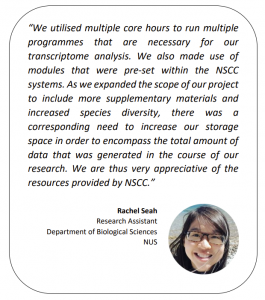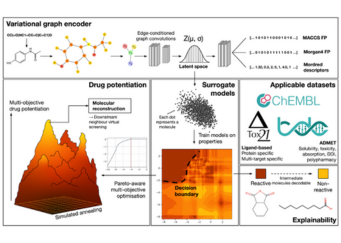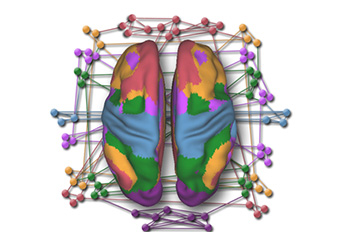Researchers at NUS are tapping HPC resources to gain a deeper understanding on the visual systems of jumping spiders in order to discover how species adapt and diversify.
Visual systems in animals allow them to see and make sense of the world based on light and colours. Opsins, the main visual pigments
found in the retinas of animals, determines their light sensitivity to the world. Studies have shown that lighting conditions can influence the variability of opsins abundance.
 Among the invertebrates family, limited available evidence suggests that jumping spiders have excellent vision and are able to detect ultraviolet (UV) wavelengths as they possess the opsin gene rh3. As such, a team of researchers at the Department of Biological Sciences at National University of Singapore are using whole-genome sequencing of 5 different salticids spiders – Cosmophasis umbratica, Menemerus bivittatus, Phintella vittata, Siler semiglaucus and Telamonia festiva to determine the types of opsins genes that are present in jumping spiders and their light sensitivity in order to offer insights into the genetic basis of the opsins diversification and highlight the plasticity of the UV visual systems.
Among the invertebrates family, limited available evidence suggests that jumping spiders have excellent vision and are able to detect ultraviolet (UV) wavelengths as they possess the opsin gene rh3. As such, a team of researchers at the Department of Biological Sciences at National University of Singapore are using whole-genome sequencing of 5 different salticids spiders – Cosmophasis umbratica, Menemerus bivittatus, Phintella vittata, Siler semiglaucus and Telamonia festiva to determine the types of opsins genes that are present in jumping spiders and their light sensitivity in order to offer insights into the genetic basis of the opsins diversification and highlight the plasticity of the UV visual systems.
The team tapped on NSCC’s HPC resources to analyse the RNA and DNA sequences from the spiders and utilised NSCC’s platform to assemble the RNA and DNA genome sequences and run their analyses and generate phylogenetic trees to determine the molecular basis and detect changes in the genomic level of the opsins genes.
The results of this research will provide a cohesive, integrative and multi-faceted understanding of how dynamic underlying gene family evolutions are and ultimately how species adapt and diversify. More importantly, the project will provide multi-level integrative training for postgraduate and undergraduate students in a widely covered multidisciplinary environment of cutting-edge research in life sciences and environmental sciences to support national R&D activities.
To find out more about the NSCC’s HPC resources and how you can tap on them, please contact [email protected].
NSCC NewsBytes February 2022
Other Case Studies
Advancing Drug Discovery Research using NSCC HPC resources
Researchers from Nanyang Technological University (NTU) are applying variational graph encoders as an effective generalist algorithm in computer-aided drug design (CADD)....
Gaining Deeper Insights into Mental Disorders through Brain Imaging and High-Performance Computing
Researchers from NUS are leveraging supercomputing to develop better strategies for prevention and treatment to mitigate the impact of mental illness. The human brain is a marvel...
Using Digital Twin Technology to Optimise the Industrial 3D Printing Process
Researchers from the Institute of High-Performance Computing (IHPC) are utilizing supercomputers to create a digital twin that furnishes users with comprehensive information...


